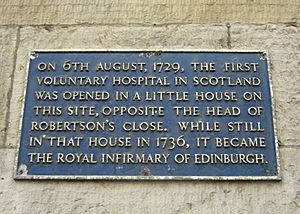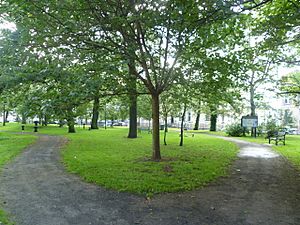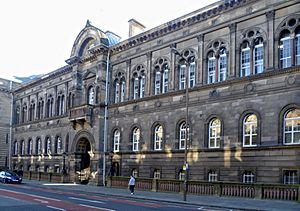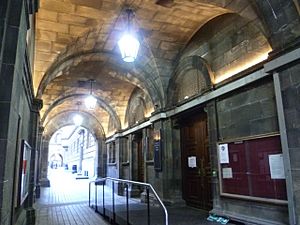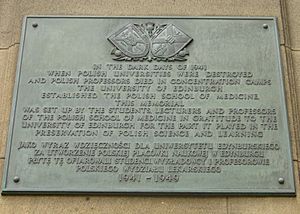University of Edinburgh Medical School facts for kids
| Type | Medical school |
|---|---|
| Established | 1726 |
| Head of School | Moira Whyte |
|
Administrative staff
|
1244 (2007/8; includes support staff) |
| Students | 2,218 (2007/8) |
| Undergraduates | 1,328 (2007/8) |
| Postgraduates | 890 (2007/8) |
| Location |
,
Scotland
,
United Kingdom
|
| Campus | The Medical School, Teviot Place Chancellor's Building, RIE Western General Hospital Royal Hospital for Sick Children |
| Colours | Dark red, light red and pale yellow (or "liver, blood and pus") |
| Affiliations | University of Edinburgh |
The University of Edinburgh Medical School is also known as Edinburgh Medical School. It is the medical school of the University of Edinburgh in Scotland. It was started in 1726, making it the oldest medical school in the United Kingdom. It is also one of the oldest medical schools in the world where English is spoken.
In 2021, this medical school was ranked 1st in the UK by the Guardian University Guide. It was also ranked among the top medical schools in the world. For example, it was 21st in the world by the Times Higher Education World University Rankings in 2013–14. Its main teaching hospital, the Royal Infirmary of Edinburgh, was thought to be the best hospital in Scotland in 2006.
Students who graduate from Edinburgh Medical School are very good at passing important exams. They are also highly wanted for jobs in hospitals and clinics.
As of As of 2017[update], the school accepts 184 medical students each year from the United Kingdom. It also takes 5 students from the European Union and 14 students from other countries. Getting in is very hard. Only about 11.5% of students who apply are accepted. The school needs some of the highest grades in the UK to get in.
The medical school has connections to 3 Nobel Prize winners. Two won the Nobel Prize in Physiology or Medicine, and one won the Nobel Prize in Chemistry. Many graduates have started medical schools and universities around the world. This includes 5 out of the 7 Ivy League medical schools in the USA.
Contents
- History of the Medical School
- The Edinburgh Model of Teaching
- How to Get In
- The Medical Course and What You Learn
- Facilities for Learning
- Research and Discoveries
- Famous Textbooks
- Royal Medical Society
- Connections Around the World
- Famous People from the Medical School
- Faculty (Teachers)
- In Popular Culture
- Doctors Pub
History of the Medical School
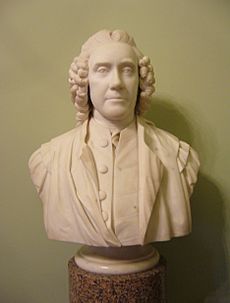
The University of Edinburgh's Faculty of Medicine officially started in 1726. But medicine was taught in Edinburgh much earlier, since the 1500s. Its beginning was helped by the creation of the Royal College of Surgeons of Edinburgh in 1505. Also, the Royal College of Physicians of Edinburgh was founded in 1681.
The University was designed like the University of Bologna in Italy. However, medical teaching was based on the University of Padua and later Leiden University. This was done to attract students from other countries. It also helped keep Scottish students in Scotland.
Since the Renaissance, a big part of medical teaching was anatomy. This is the study of the body's structure. So, Alexander Monro was made Professor of Anatomy in 1720. His son and grandson, both named Alexander Monro, also held this job. This meant a Professor Alexander Monro taught anatomy for 128 years! Over time, more professors joined. This allowed the school to give out the Doctor of Medicine (MD) degree.
Teaching medicine and surgery was very successful in the 1700s. This was thanks to the first teaching hospital and local doctors. By 1764, so many medical students were there that a new 200-seat Anatomy Theatre was built. For many years, until the First World War, Edinburgh Medical School was seen as the best in the English-speaking world. Many great teachers like William Cullen and James Gregory attracted students.
The Royal Infirmary of Edinburgh
The first charity hospital in Scotland was the Edinburgh Infirmary for the Sick Poor. It was for both helping people and teaching students. Alexander Monro led this project. He was supported by George Drummond, a politician who wanted Edinburgh to be a top medical city. The Royal College of Physicians raised £2000 for the hospital by 1728.
The Edinburgh Royal Infirmary started in a small house. It was rented from the University of Edinburgh. Only four beds were available at first in 1729. Students could only visit with two tickets to prevent too many people.
In 1738, building began on a new hospital. It was designed by William Adam. In 1741, a new 228-bed hospital opened. It was located near Surgeons' Hall. This new hospital had rooms for medical and surgical patients. It also had cells for patients with mental health issues. There was even a surgical operation theatre with seats for 200 students.
Later, because it was too crowded, a new hospital was built. David Bryce designed the new Royal Infirmary of Edinburgh on Lauriston Place. This was close to the university. In 2003, a new 900-bed Royal Infirmary opened in Little France. This replaced the old one.
The Royal Botanic Garden of Edinburgh
The Edinburgh Botanic Garden was started in 1670. It was for studying medicinal plants. Dr Robert Sibbald and Dr Andrew Balfour created it. It helped develop the study of how medicines work (Pharmacology) and Chemistry. The garden moved several times. It finally moved to its current location in Inverleith after 1820. It is now the second oldest botanic garden in Britain.
In the 1800s, new sciences grew in Edinburgh. These included Physiology (how the body works) and Pathology (the study of diseases). Public Health and Psychiatry also developed. Midwifery, which is helping with childbirth, became a required part of medical studies.
Women and Medical School
In 1869, Sophia Jex-Blake was allowed to attend some medical classes. This was a big step in the fight for women to become doctors. At this time, British medical schools often refused to accept women. Sophia Jex-Blake convinced Edinburgh University to let her and her friend, Edith Pechy, attend lectures. Full equality for women in medicine at Edinburgh Medical School took another 20 years to achieve.
The Medical School at Teviot Place
By the 1860s, the medical school was getting too small. In 1880, a new Royal Infirmary was built. So, new medical buildings started being built in Teviot Place. They were finished by 1888. These buildings were next to the Royal Infirmary. They had proper places for teaching, research, and labs. This area became known as the "New Quad."
Sir Robert Rowand Anderson designed the new buildings. He chose an Italian Renaissance style. He thought it was best for a scientific medical school. The design included a large Anatomy Museum. It had displays of skeletons, from whales to humans. It also had dissecting rooms and a grand lecture theatre. Today, the buildings at Teviot Place are used for teaching subjects like biochemistry and anatomy.
The Polish School of Medicine
The Polish School of Medicine was created in 1941 during World War II. It was for Polish soldiers in Britain who wanted to study medicine. Classes were taught in Polish. The main teaching hospital was the Royal Infirmary of Edinburgh. A special hospital, The Paderewski Hospital, was used for Polish soldiers and civilians.
This school was started by Lt. Col. Professor Francis Crew and Lt. Col. Dr Antoni Jurasz. It closed in 1950. Many students graduated from this school. A bronze plaque remembers the Polish School of Medicine. It is in the Medical School's Quadrangle in Teviot Place.
The Edinburgh Model of Teaching
The Edinburgh Model was a special way of teaching medicine. It was developed by the University of Edinburgh in the 1700s. Many other medical schools around the world copied it. This included the Perelman School of Medicine at the University of Pennsylvania and McGill University.
This model offered students studies in all areas of science, not just medicine. It had a two-part education system. Many students could start, but only a few graduated. The rules for getting an MD degree were very strict. Students had to attend almost all lectures. They had to study for at least 3 years. They also had to pass oral and written exams in Latin. Plus, they had to write a Latin thesis and defend it.
Because of this, most students came to Edinburgh to learn medicine for about a year. They would then leave because getting a full degree was expensive. Also, an MD degree was not always needed to practice medicine back then. Between 1765 and 1825, only 20% of Edinburgh students earned an MD.
Later, this model became a more formal university medical education. It spread globally through Edinburgh graduates. In 1825, medical education increased to four years. In 1833, English replaced Latin for exams.
How to Get In
Getting into the University of Edinburgh to study medicine is very competitive. In 2013, there were 2150 applications for 190 spots from the UK and EU. That's 11 people for every spot! For international students, there were 715 applications for only 17 spots.
To get in, you need very good grades. For example:
- SQA Highers: AAAAB, including Chemistry and two of Biology, Maths, or Physics.
- GCE A Levels: AAA, including Chemistry and one of Biology, Maths, or Physics.
- International Baccalaureate: 37 points, with high scores in Chemistry and another science.
You also need to take the UK Clinical Aptitude Test (UKCAT). Most applicants are not interviewed.
The main medical course (MBChB) takes 6 years. It includes a special "intercalated year" between years 2 and 3. In this year, students study a different science subject and earn a Bachelor of Medical Sciences (BMedSci) degree.
The Medical Course and What You Learn
The main medical degree is the Medicine (MBChB) course, which takes 6 years. There's also a new 5-year program for healthcare workers already in Scotland.
The course covers many important topics throughout all six years. These include:
- Biomedical science (how the body works)
- Psychological aspects of medicine (how the mind affects health)
- Public health (keeping communities healthy)
- Evidence-based medicine (using research to guide treatment)
- How to talk to patients
- Emergency care
- Medical ethics (right and wrong in medicine)
- And more!
Years 1 and 2
In the first year, students learn about Biomedical Science and Health, Ethics and Society. This teaches them the basic science and social ideas for practicing medicine. They also learn how to talk to patients and basic first aid. Students visit GP practices early on to learn how to communicate with patients. They also study a healthcare topic in a real clinic.
In the first semester, students learn the "fundamentals of medicine." This includes genetics, anatomy, and how the body fights infections. In the second semester, they study body systems like the respiratory (breathing) and heart systems.
In Year 2, students continue studying body systems. They learn about the nervous system, digestion, hormones, and kidneys. They also learn how to understand medical research papers. Students practice taking patient histories and doing basic exams in GP placements.
Year 3
Since 2016, all students do an "intercalated degree" in Year 3. This means they spend a year studying a specific science subject in depth. They can choose from over 20 different fields. At the end of this year, they get a Bachelor of Medical Sciences (BMedSci) degree.
Years 4 and 5
Years 4 and 5 focus on clinical teaching. Students learn about major medical and surgical specialties. They spend a lot of time in hospitals. They learn by watching doctors, attending clinics, and going on ward rounds. They also attend lectures and do research.
Year 6
The final year finishes the clinical training. Students learn about General Medicine, General Practice, General Surgery, and Emergency Medicine. They also learn about caring for the elderly. Near the end of the year, after their final exams, students do a 6-week elective. This is often spent experiencing medicine in another country. They also do a 6-week assistantship, working like a junior doctor.
Facilities for Learning
First and second-year teaching mostly happens in the Old Medical School buildings in Edinburgh city centre. The later clinical years (4, 5, and 6) are spent in three main teaching hospitals:
- The Royal Infirmary of Edinburgh
- The Western General Hospital
- The Royal Hospital for Sick Children
The Chancellor's Building at Little France is next to the new Royal Infirmary. It was opened in 2002 by HRH Prince Philip. This building houses the new medical school.
Edinburgh Electronic Medical Curriculum (EEMeC)
EEMeC was an online learning system for medical students. It allowed students to access course information safely. It also helped them track their progress and see exam results. EEMeC was one of the first systems like it in the world when it was created in 1998. It was a model for other medical schools. In 2005, the University of Edinburgh won an award for EEMeC. In 2017, EEMeC was replaced by LEARN, the University's main online learning system.
Research and Discoveries
Edinburgh Medical School is a top place for medical research. In 2014, it was ranked 3rd in the UK for Neuroscience and Biological Sciences. It was also in the top 5 for Clinical Medicine.
The University of Edinburgh is part of the Russell Group of universities. These universities get a lot of research funding in the UK. The Medical School gets over £45 million each year for research.
The University has many important research centers. These include 7 MRC Centres (Medical Research Council), a BHF Centre (British Heart Foundation), and a Wellcome Trust Centre.
Recent research and discoveries from Edinburgh include:
- 2013 – Scientists successfully made human blood using stem cells.
- 2014 – Researchers grew a living organ, the thymus, for the first time in mice.
- 2015 – Researchers created a UK national test for prescribing medicine, which all graduating UK medical students now take.
Famous Textbooks
Many medical textbooks used worldwide were written by Edinburgh graduates:
- Robert Muir wrote Muir's Textbook of Pathology.
- John George Macleod wrote Macleod's Clinical Examination.
- John C. Boileau Grant wrote Grant's Atlas of Anatomy.
- Stanley Davidson wrote Davidson's Principles and Practice of Medicine.
- Sir Robert Hutchison, 1st Baronet wrote Hutchison's Clinical Methods.
- Daniel John Cunningham wrote Cunningham's Manual of Practical Anatomy.
Royal Medical Society
The Royal Medical Society is the medical student society at the University of Edinburgh. It is the oldest medical society in the UK, started in 1734. It got its "Royal" name in 1778. It is the only student society in the UK with a Royal Charter. It has its own building with a historical library and meeting rooms.
This society was very important for the Medical School's good reputation. It encouraged open discussions and helped students connect. Today, the Society still promotes learning through talks and events. It also runs social events like the "White Coat Pub Crawl." Students can apply for grants to help fund their medical electives (special study trips). The Society is run by students.
Connections Around the World
The Edinburgh Medical School has strong connections to the United States and Canada. Its graduates helped start 5 out of the 7 Ivy League medical schools in the USA. These include Harvard and Yale. The McGill University Medical School in Montreal was also designed like Edinburgh's. Many early doctors for US presidents were trained at Edinburgh. The school also has a Scottish-Canadian Medical Programme for Canadian students.
Edinburgh Medical School has also partnered with the Christian Medical College, Vellore in India. They are working together to create a Masters of Family Medicine program.
Famous People from the Medical School
Many important people have studied or taught at Edinburgh Medical School. These include Nobel Prize winners and pioneers in medicine.
Faculty (Teachers)
Here are some notable people who taught at the Medical School:
| Name | Department | Notability | Reference |
|---|---|---|---|
| Robert Sibbald | Prof. of Medicine 1685–1722 | Scottish doctor, first to describe the blue whale. | |
| John Rutherford | Prof. of Practice of Medicine 1726–1765 | Scottish doctor, started clinical teaching in Edinburgh. | |
| William Cullen | Prof. of Chemistry and Medicine 1755–1766, Prof. of Institutes of Medicine 1766–1773, Prof. of Medicine 1773–1790 | Scottish doctor, showed how to make artificial refrigeration. | |
| James Syme | Regius Chair of Clinical Surgery 1833–1848 | Scottish surgeon, invented the Mackintosh coat. | |
| Joseph Lister | Regius Chair of Clinical Surgery 1869–1877 | Scottish surgeon, developed antiseptic surgery using carbolic acid to clean tools. | |
| Edward Albert Sharpey-Schafer | Chair of Physiology 1883–1933 | English scientist, helped start the study of endocrinology (hormones). | |
| Vincent du Vigneaud | National Research Council Fellow 1928–1929 | American biochemist, discovered oxytocin, won the 1955 Nobel Prize in Chemistry. | |
| Alexander Fleming | Rector 1951–1954 | Scottish biologist, discovered penicillin, won the 1945 Nobel Prize in Physiology or Medicine. | |
| Michael Woodruff | Chair of Surgical Science 1957–1976 | British transplant surgeon, did the first kidney transplant in the UK in 1960. | |
| Edwin Southern | Post-doctoral researcher MRC Mammalian Genome Unit 1967–1985 | Developed the Southern blot (a lab technique). | |
| Andrew H. Wyllie | Prof. Experimental Pathology 1992–1998 | Scottish pathologist, discovered the importance of programmed cell death. | |
| Edvard Moser | Post-doctoral researcher 1994–1996 | Norwegian neuroscientist, discovered brain cells called grid cells, won the 2014 Nobel Prize in Physiology or Medicine. | |
| May-Britt Moser | Post-doctoral researcher 1994–1996 | Norwegian neuroscientist, discovered brain cells called grid cells, won the 2014 Nobel Prize in Physiology or Medicine. | |
| Sir Ian Wilmut | Prof. Emeritus 2006–present | Scottish embryologist, first to clone a mammal, Dolly the sheep. | |
| Jamie A. Davies | Chair of Experimental Anatomy 2007–present | British scientist, first to grow a kidney from stem cells. | |
| Clare Blackburn | Chair of Tissue Stem Cell Biology 2011–present | British scientist, first to grow a whole organ, a thymus, inside an animal. |
In Popular Culture
The Edinburgh Medical School has appeared in many TV shows and movies:
- In the TV show NCIS, the character Dr. Donald "Ducky" Mallard studied medicine at Edinburgh.
- In the BBC show Doctors, Dr. Emma Reid studied medicine there.
- The film The Last King of Scotland features a main character who graduated from Edinburgh.
- The famous detective Sherlock Holmes was based on Dr. Joseph Bell, who was a lecturer at Edinburgh. The author, Sir Arthur Conan Doyle, also studied there.
- In the Australian TV show The Doctor Blake Mysteries, Dr. Lucien Blake studied medicine at Edinburgh.
Doctors Pub
"Doctors" is a pub located right across from the medical school buildings. It has been a popular spot for Edinburgh Medical School students and graduates since the 1970s. The walls are decorated with plaques and photos that tell stories of its history.


